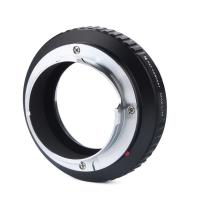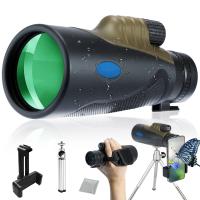How Do Microscopes Work ?
Microscopes work by using lenses to magnify small objects or organisms that are too small to be seen with the naked eye. The lenses in a microscope bend the light that passes through them, which allows the user to see a larger image of the object being viewed. There are two main types of microscopes: light microscopes and electron microscopes.
Light microscopes use visible light to illuminate the object being viewed. The light passes through the lenses and is focused on the object, which makes it appear larger. Light microscopes can magnify objects up to 1,000 times their original size.
Electron microscopes use a beam of electrons instead of visible light to illuminate the object being viewed. The electrons are focused using magnetic lenses, which allows for much higher magnification than is possible with a light microscope. Electron microscopes can magnify objects up to 10 million times their original size.
1、 Optical Microscopy
Optical Microscopy is a type of microscope that uses visible light and lenses to magnify small objects. The basic principle of optical microscopy is to use a series of lenses to magnify the image of an object. The lenses bend the light that passes through them, allowing the viewer to see a larger image of the object.
The first lens, called the objective lens, is located close to the object being viewed. This lens magnifies the image of the object and sends it to the second lens, called the eyepiece lens. The eyepiece lens further magnifies the image, allowing the viewer to see a larger and clearer image of the object.
In recent years, there have been advancements in optical microscopy, such as confocal microscopy and super-resolution microscopy. Confocal microscopy uses a laser to scan the object being viewed, creating a 3D image. Super-resolution microscopy uses fluorescent dyes to create images with higher resolution than traditional optical microscopy.
Overall, optical microscopy is a powerful tool for studying small objects and has been used in a variety of fields, including biology, materials science, and nanotechnology.
2、 Electron Microscopy
Electron Microscopy is a type of microscopy that uses a beam of electrons to create an image of a specimen. Unlike traditional light microscopes, which use visible light to magnify an image, electron microscopes use a beam of electrons that are focused using magnetic lenses. This allows for much higher magnification and resolution than is possible with light microscopes.
The basic principle of electron microscopy is that a beam of electrons is directed at a specimen, and the electrons interact with the atoms in the specimen to produce an image. The electrons can be scattered, absorbed, or transmitted through the specimen, and these interactions are detected and used to create an image.
There are two main types of electron microscopy: transmission electron microscopy (TEM) and scanning electron microscopy (SEM). In TEM, the electrons pass through a thin section of the specimen, and the resulting image shows the internal structure of the specimen. In SEM, the electrons are focused on the surface of the specimen, and the resulting image shows the surface structure.
The latest point of view in electron microscopy is the development of cryo-electron microscopy (cryo-EM), which allows for the imaging of biological specimens in their native state. Cryo-EM involves freezing the specimen in a thin layer of ice, which preserves its structure and allows for high-resolution imaging. This technique has revolutionized the field of structural biology, allowing researchers to study the structure of proteins and other biomolecules at the atomic level.
3、 Scanning Probe Microscopy
Scanning Probe Microscopy (SPM) is a type of microscope that uses a physical probe to scan the surface of a sample to create an image with high resolution. The probe is typically a sharp tip made of a conductive material, such as tungsten or platinum, that is attached to a cantilever. The cantilever is then moved across the surface of the sample, and the interaction between the probe and the sample is measured to create an image.
There are several types of SPM, including Atomic Force Microscopy (AFM) and Scanning Tunneling Microscopy (STM). AFM measures the force between the probe and the sample, while STM measures the flow of electrons between the probe and the sample. Both techniques can achieve atomic-scale resolution, allowing researchers to study the surface properties of materials at the nanoscale.
The latest point of view in SPM research is the development of new probes and techniques that can measure not only the topography of a sample, but also its chemical and physical properties. For example, SPM can be used to measure the electrical conductivity of a material, or to study the interactions between molecules on a surface. These advances are opening up new possibilities for studying the properties of materials at the nanoscale, and could have important applications in fields such as materials science, nanotechnology, and biophysics.
4、 Confocal Microscopy
Confocal Microscopy is a type of microscopy that uses a laser beam to scan a sample and create a three-dimensional image. The laser beam is focused on a single point on the sample, and the emitted light is collected by a detector. The detector only collects light that is in focus, which allows for the creation of a sharp image with high contrast.
The basic principle of confocal microscopy is similar to that of a regular microscope, but with the added benefit of being able to create a three-dimensional image. The laser beam is used to excite fluorescent molecules in the sample, which emit light that is collected by the detector. The laser beam is scanned across the sample, and the emitted light is collected at each point to create a three-dimensional image.
One of the latest developments in confocal microscopy is the use of super-resolution techniques, which allow for even higher resolution images. These techniques use specialized fluorescent molecules that can be switched on and off, allowing for the creation of images with resolutions beyond the diffraction limit of light.
Overall, confocal microscopy is a powerful tool for imaging biological samples with high resolution and contrast. Its ability to create three-dimensional images and use super-resolution techniques make it an essential tool for many areas of research, including neuroscience, cell biology, and developmental biology.





























